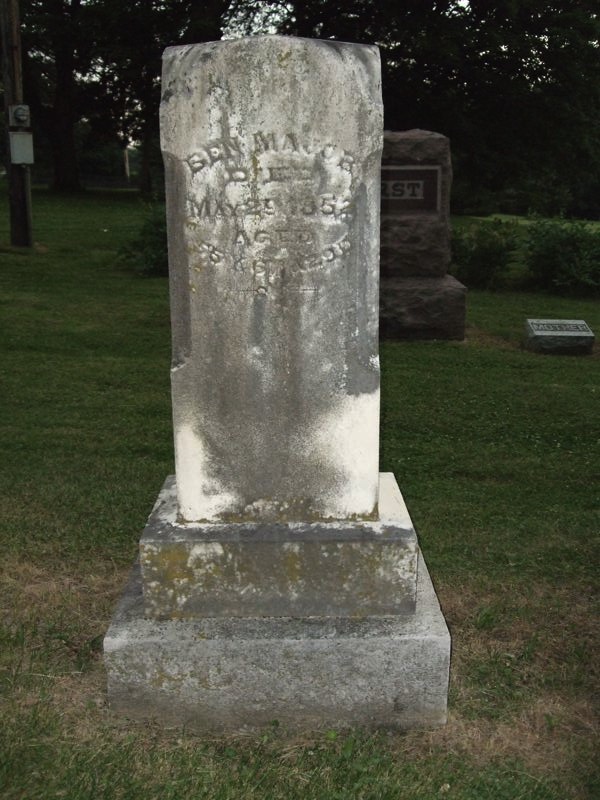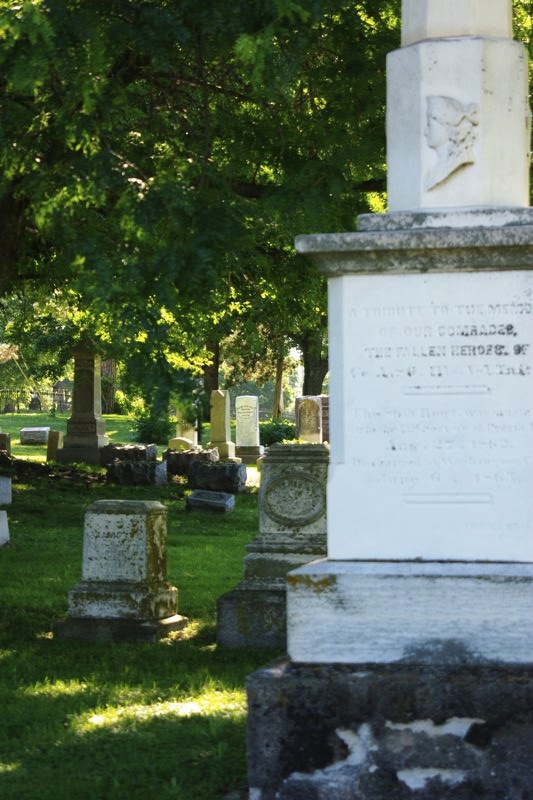Ben Major
1796-1852
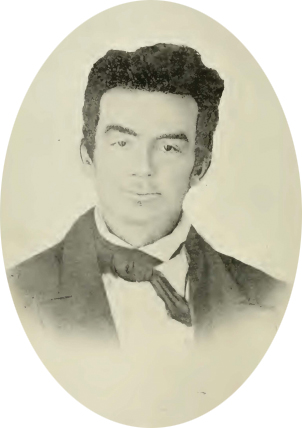
The Life Of Ben Major
Ben Major was born in Franklin county, Kentucky, Oct. 31st, 1796. He was the son of John and Judith (Trabue) Major. His paternal and maternal ancestors were French Huguenots, who came to the colony of Virginia in 1699, after the revocation of the Edict of Nantes in 1685. Previous to this they had been refugees in England, and were sent to Virginia by the charity of King William, and became naturalized by a particular law for that purpose.
In all, there were about eight hundred men, women and children who had fled from France on account of their religions opinions.
They first settled in Powhatan county, but from that point they scattered throughout the colony, some settling on a rich tract of land about twenty miles above the falls of James River, the Majors and Trabues going to Franklin county.
The memory of their first home was preserved by the name Powhatan being given as a Christian name to their children.
About 1700 many families came to Kentucky from Virginia, among them Mr. Major's father and mother and other relatives. Coming there before Kentucky was admitted to the Union, they settled in that part of the State that was afterward Franklin county, supposed to be named from the county they had left in Virginia.
That they were people of culture and refinement will be seen from books, silver and furniture over one hundred years old still in possession of the family. Here the subject of this sketch was born and passed his childhood. His father was a farmer, as were nearly all the settlers in Franklin county at that time. They made homes similar to those still seen in the blue grass regions, and they were like no other farms in the United States.
The farms were large, the farm houses being placed in the center, surrounded by wide pastures, more like parks in England. They engaged in stock-raising, and in the cultivation of corn and tobacco, and in a few years were in easy circumstances. They spun their own cotton, flax and wool, and wove cloth, sending the surplus to New Orleans, and exchanging it for foreign goods.
In such surroundings Ben Major's youthful days were spent. His education was derived from private teachers, as schools were few inn umber. Two or three families would employ a teacher, or they would employ one in each family; rarely some were sent away to college.
His education seems to have been above that of the average young man of the day, as well-worn volumes of Shakespeare, Paradise Lost and Lalla Rookh will attest, and he was ever a reader and student throughout his life.
When about eighteen years of age, an older brother, John, went to New Orleans to engage in business, and the following year Ben went to assist him. They continued in business for almost five years.
While they were there their mother died, in 1817, and the next year John died with yellow fever, leaving Ben alone in New Orleans. He closed up the business the following year and returned to Kentucky.
His father, in the meantime, had sold his farm in Franklin county and moved to the southern part of the State, into Christian county, which was being settled at that time. After his return from New Orleans, he spent some time in the neighborhood of his old home, visiting relatives and renewing old acquaintances. Here he met Miss Lucy Davenport, whom he married Jan. 15, 1820. About this time his only sister, Eliza Major, married William Davenport, a brother of his wife.
After his marriage he went to Christian county, and opened a new farm, and soon made for his family a comfortable home. His father had brought his slaves from Virginia. and when he moved to Christian county, took them with him. Here, with the help of his slaves, Ben Major soon had his farm under cultivation, and was one of the foremost business men of the county.
About 1827 or 8, his health failed: indeed his health had not been good since leaving New Orleans. After trying many doctors with little or no success, he was led to try the Thompsonian system, and after much study and successful treatment of himself he began the practice of medicine: and continued it for oyer three rears before leaving Kentucky, and afterward in Illinois, where doctors were few, and from eight to twenty miles distant. As he was a good nurse as well as a physician, he was often called upon for his services, and there are people in Eureka today who owe their lives to his skill and gentle nursing.
He was almost a physician without price, as his services were nearly always gratuitous. If any of the neighbors were sick, he would leave his work and stay with them until the danger was past.
From his childhood he had serious doubts on the slavery question, and with such doubts made the subject one continuous study. As he reached mature years, these doubts were swept away, and he became convinced that the whole system was radically wrong; and being a man who acted upon his own convictions of what his particular duty was to his God and fellowmen, he marked out a course and matured plans for his own guidance; a course which was at variance with all his early teachings, and antagonistic to all his family and society relations.
But fully realizing his duty to the dependent creatures under his control, and the obligations he owed to his children fast gathering around him, he never once hesitated (although at that time it meant almost financial ruin), but determined not only to liberate and colonize his slaves, but at the same time to liberate himself and his immediate family from even a taint of the curse of slavery. He realized that his slaves were not fully prepared for so great a change, and spent many months, even years, in educating them to the proper point; spent long evenings in reading to them all available matter that would in any way shed light on their darkened minds. At first they absolutely refused to entertain a thought of freedom on any grounds. With a kind and considerate master and mistress, and surrounded by all the comforts of which their ignorant minds could conceive, they had no desire for a change. But by a careful and well devised system of teaching, he finally brought them to consider the matter in the proper light, and consent to be colonized and become free men and women.
Late in the spring of 1831, leaving all his farming operations in the care of his trusted slaves, he started with buoyant spirits, a light heart, and, we may add, a clear conscience, to find a home in some free State; and after a long journey alone and on horseback, he reached what is now Woodford county, Illinois, and found a small settlement on the banks of Walnut Creek.
This being the spring after the deep snow, he found in June evidences of it in the drifts along the few fences. He was well pleased with all the conditions and with the noble band of men and women whom he found here. His practical mind was much impressed with the boundless prairies and the grand forests, and with his penetrating vision he saw in this land great possibilities for the future, where he and his sons and daughters might, by their own exertions and toil make free homes for themselves and those that might follow. Being now fully satisfied that he had found that for which he sought, his mission in Illinois for the present ended, he returned to Kentucky, not being able or prepared to purchase or enter land. He returned to Illinois in 1833, and entered and purchased about eight hundred acres of land, locating on the east side of the Grove, choosing for his future home a tract one half mile southeast of where Eureka College now stands. He then returned to Kentucky to fully carry out all his plans, for which he had been working so long. He could make no arrangements for the transportation of his colored people in 1834, so they were hired out to other planters for one year, the slaves to receive their own wages.
In the fall of 1835, all things being in readiness, he sent his agent to New York with the slaves, who were taken in charge by the American Colonization Society and sent to the colony of Liberia, Mr. Major being a life member of the Society and an earnest reader for many years of the African Repository, its official organ. He incurred all the expense of sending the negroes, and furnished them with clothing, supplies and implements. After reaching their new home, a regular correspondence was kept up, and many welcome letters were written and received, they invariably addressing him as "Dear Father." Many of these treasured letters are still kept by members of the family as sacred mementos.
Nothing had been heard definitely from these people since 1858, when one of the negroes, whose father and mother had been slaves of Mr. Harlan and Mr. Major, was sent to this country on official business for the colony, and while in the United States visited Eureka and spoke in the old church, and gave an account of their manner of living, describing their school system and church advantages.
He thought the prospect for the future of Liberia was good. But of late years news has come that the native tribes have caused much trouble to the colony.
In 1827 or 8, Ben Major, who had long been a member of the Baptist Church, with many others in that part of Kentucky with like views, united and organized the Christian Church at Noah Springs, which was a noted landmark in the early days of the A. Campbell reformation.
In October of 1834 he loaded his goods in wagons drawn by oxen, and started for the Illinois home. The family at this time numbered seven persons, Ben Major and wife, Lucy and five children, John, Judith A., William, Ben and Lucy. (After coming here they were blessed with three other children, Jo, Ann Eliza and Chastine.) Mrs. Major with the three youngest children rode in a buggy, the other two children, fourteen and ten years of age respectively, riding on horse back. Two of the slaves assisted with the stock as far as Carlinville, Ill., returning to Kentucky from there. And thus began what would seem to us a long, tedious journey. But in after years the trip between Illinois and Kentucky was often made, before railroads were in existence.
The time taken in moving out, some two weeks, was enjoyed by all, the weather being delightful. Reaching Walnut Grove the last day in October, they, after viewing their future home, went to William Davenport's, who had moved out the spring before, and had settled at the head of the Grove. It was a joyful meeting in a new land, with an untried future facing them.
After resting here a few days, he moved on his own farm into a house built of logs and containing two rooms, in which they lived two years, the time being passed in opening up a new farm. Prairie had to be broken and fences made. While there was no clearing to be done, as in Kentucky, yet rails had to be made, and there being at that time excellent timber, the ax formed an important factor. Neighbors were far apart, but neighbors they were in fact and deed. They found such men as John Oatman, Joseph Henry, Noel Meek, Caleb Davidson, David Deweese, Daniel Travis, William Davenport and Mordecai Bullock, with some others.
In 1835 and 6, many more came, prominent among them, B. J. Radford, Elijah Dickinson, E. B. and A. M. Myers and Thomas Bullock, all seeking and finding pleasant homes in this free land.
The planting of fruit trees of all varieties was one of their first cares, sending to Tennessee and even as far as Harper's Ferry, Va., for them, which in a few years yielded them abundant crops. Small fruits grew wild in great abu1ldance. Game of all kinds was plentiful, and to be had merely for the taking.
After living in the log house for two years, Mr. Major began the erection of a frame house, which required several years for its completion. The frame in all its parts had to be hewn in the timber, and all the lumber hauled from a saw-mill on the Illinois River, more than twenty miles distant, but, after completion, making a very comfortable and, in those clays, rather an imposing farm house.
Here he planted fruit, shade and ornamental trees, many of which remain. On his arrival here he found a few members of the Christian Church, and a church organization, but weak in numbers, under the care of Elder John Oatman. In 1835 it was reorganized, and Ben Major chosen as one of the elders, an office which he retained until his death. At first the meetings were held in the log houses of the settlers. In warm weather the meetings were regularly held in the barns of Uncle Caleb Davidson and David Deweese, and in the shady forest. Afterward meetings were held in the school-house until the old church was built, on the site of the present cemetery. This old church has been gone many years, but around it, for many of the older people of Eureka, cling many sweet memories.
As the children of these early settlers grew up, they one and all realized the need of a higher education, the teachers they then employed not being able to instruct their pupils farther than the "three R's." After much thought and consultation, they determined to make personal sacrifices and if possible employ better teachers.
Money was scarce, and how it was accomplished, and how they builded better than they knew, is recorded in this history. Of the many personal sacrifices made, only those who made them know. After many unsuccessful attempts, they finally procured the services of A. S. Fisher, and the foundation-stone of Eureka College was laid.
Though death claimed Ben Major in the prime of his useful manhood, he yet lived to see the beginning of his fondest hopes realized. In the spring of 1852, his brother-in-law, William Davenport, while in St. Louis, came in contact with some cases of cholera, and after returning home was taken sick, but recovered, no one supposing at that time that cholera was in our midst.
His wife, Mr. Major’s sister, was the next victim. They sent hastily for her brother. The family were at breakfast when the messenger arrived, and without a thought for himself, leaving the meal untasted, he hastened to his sister's side, there to remain until death released her from her suffering.
All then knew that the dread epidemic had gained a firm foothold. Returning home accompanied by his nephew, Joseph Davenport, both were taken ill. From the first, Mr. Major seemed to realize that his case was a hopeless one, and showed great presence of mind and unselfish devotion to others in directing their treatment. So, heroically and without complaint, he breathed his last. Joseph Davenport survived him only a few hours. Another nephew, John Davenport, also died, making four deaths in so short a time.
These were indeed sad times for the bereaved families. Many were the kind offices rendered. The loving sympathy of the entire community was tendered the saddened families, all feeling keenly the loss of a dear and tried friend. Departing this life with so many of his Christian plans only fairly begun, yet he died in the firm, unshaken faith that his many co-workers would complete the work which they had so auspiciously begun.
-History Of Eureka College – pages 111-122
![]()
Directions to the Grave Of Ben & Lucy Major
Ben Major was born October 31, 1796 and died May 24, 1852 at 55 years of age. He is buried in the Olio Township Cemetery, also known as Eureka Cemetery in Eureka, Illinois. The city is located just east of Peoria on Hwy. 24. In the town center turn right on Hwy. 117. and go past Eureka College, and you will see the cemetery on the left. This cemetery was at one time the old Eureka Christian Church Cemetery. The building has long been gone. Enter into the main entrance of the cemetery and take the second drive to the left. Go to the top of the hill. Stop the car. Go into the section to the right. It is the oldest part of the cemetery. Go to the NE corner to locate the Major's family plot.
GPS Location
40.711972,-89.271378
Grave Facing West
Location in Cemetery: Div A Section A Lot 7 Grave #5
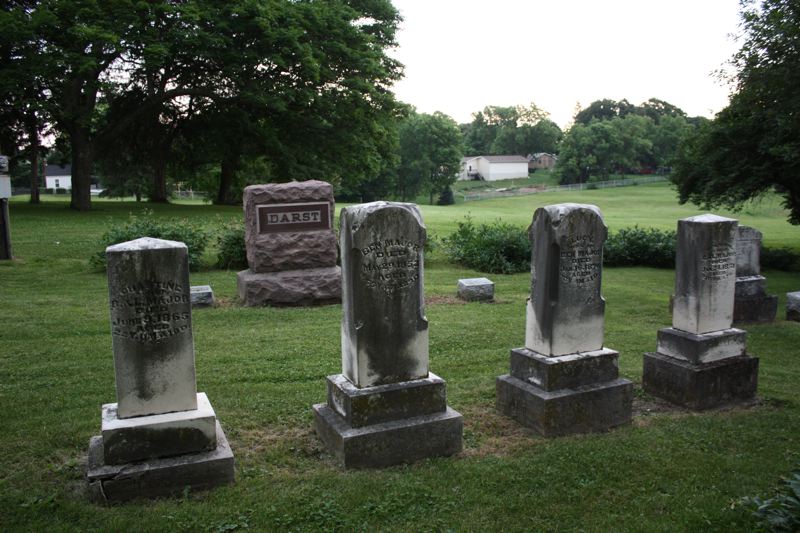
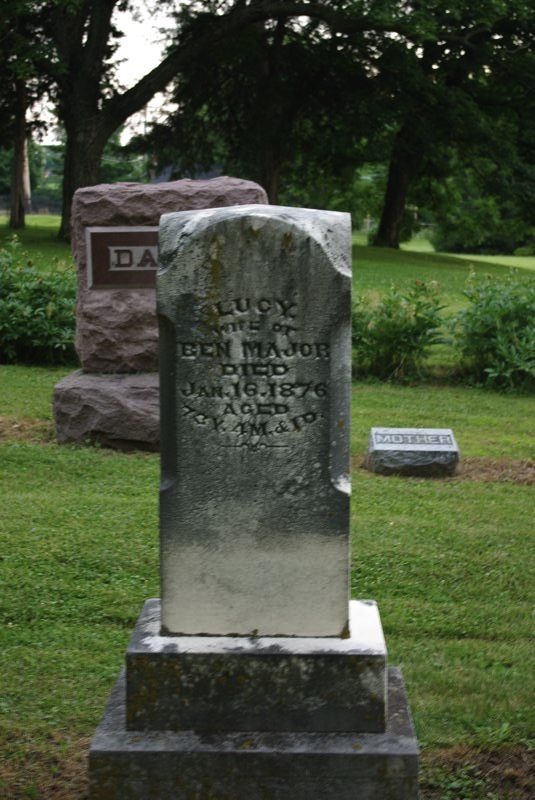
Lucy
Wife Of
Ben Major
Died
Jan. 16, 1876
Aged
73Y 4M. 1D
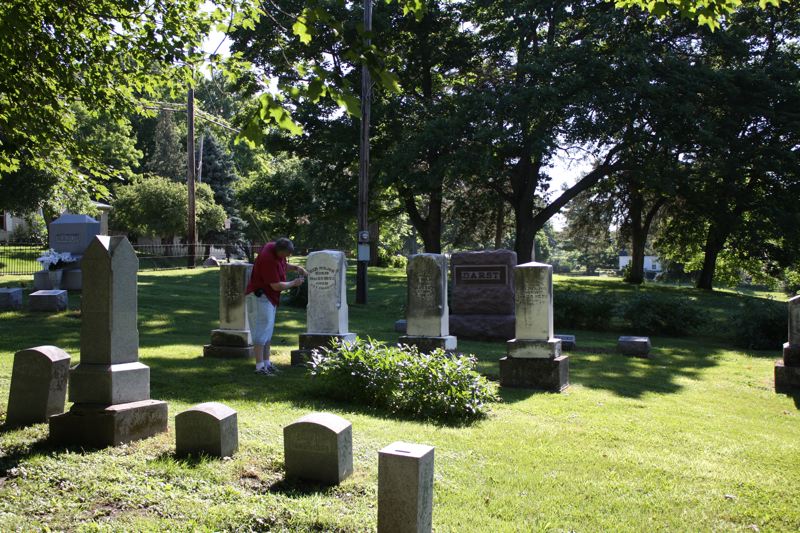
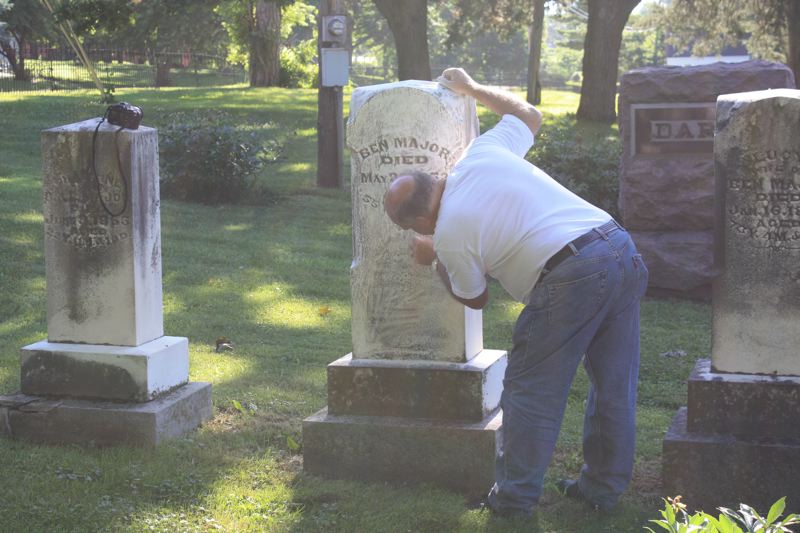
Wayne Kilpatrick Chalking The Ben Major Monument
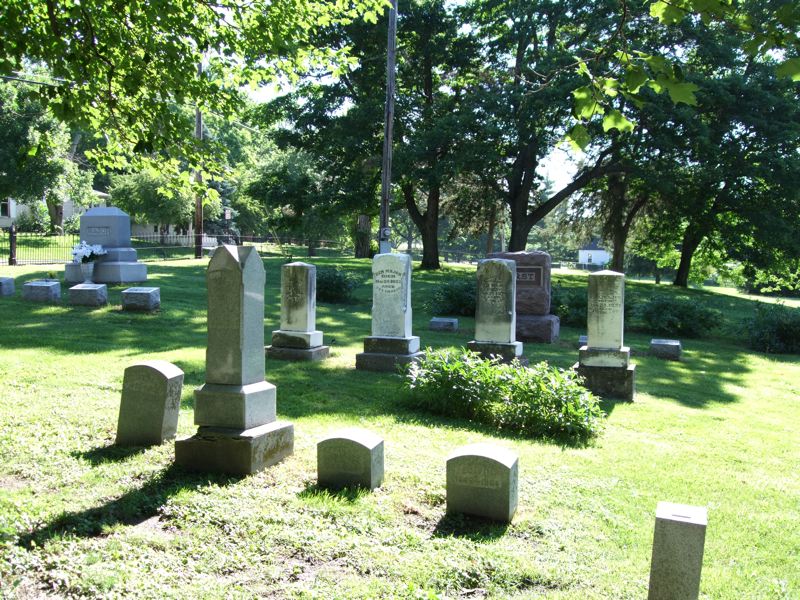
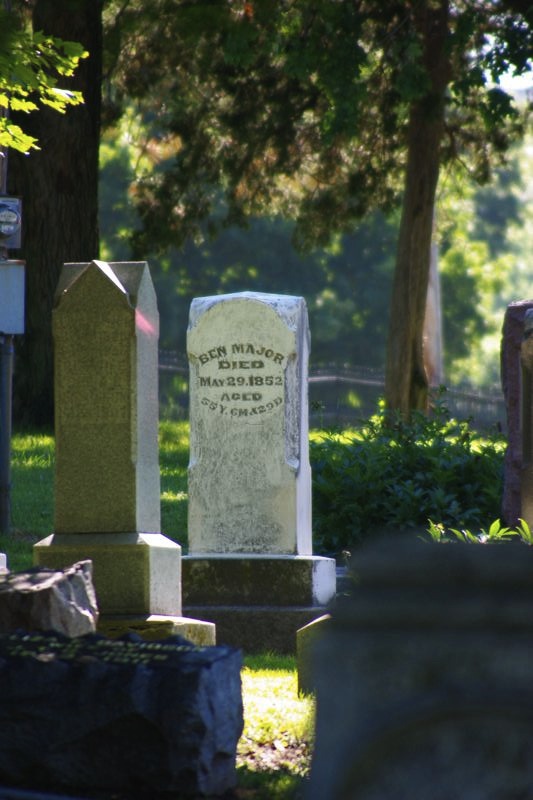
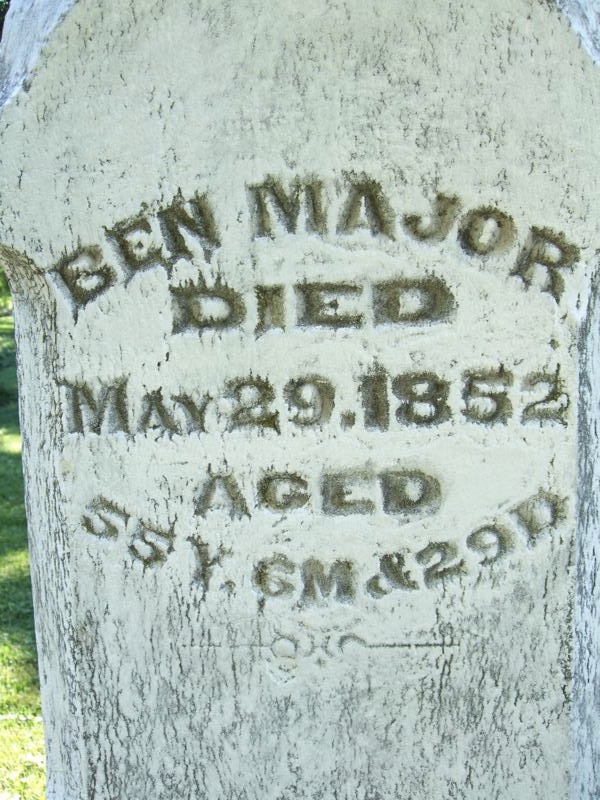
Ben Major
Died
May 29, 1852
Aged
55Y, 6M & 29D
![]()
Special Thanks
In June, 2009 Tom L. Childers, C. Wayne Kilpatrick and Scott Harp traveled about 3000 miles in one week through parts of Tennessee, Missouri, Illinois, Indiana and Kentucky. During this time we found the graves of 75 church leaders in the Restoration Movement. Chronicling these leaders into websites has been time consuming. Many thanks to Tom and Wayne in helping to take photos, share the driving, and putting up with your web master's slave-driving effort to see as many as we did in the time we had. Their photos as well as some of mine are seen on this site. When we arrived at Olio Twp Cemetery, it was late in the evening, and a summer storm was on its way. I had called Rosemary Hartter, the manager of the cemetery, weeks in advance to gather information. When we arrived on Saturday evening, I called her and she was most gracious to come to the cemetery after hours to assist us in finding all the graves. She and the staff at the cemetery have been most gracious to help, and for this we say a special thanks to them.
![]()
